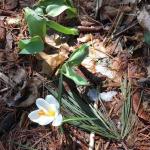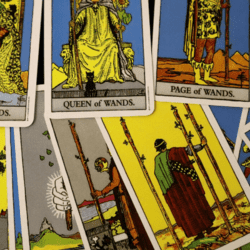In my part of the world, the early blooms of Spring are beginning their slow, determined crawl up through the worn and weary crust of the earth, not so much punching their way into view as just grinding it out centimeter by centimeter. I’m reminded of Sisyphus, that self-important, braggart of a mortal punished by the ancient Greek gods for his deceitfulness, struggling day after day to shove an almost unbearably heavy stone up the side of a dauntingly steep mountainside. Each day he almost reaches the pinnacle of the mountain only to have the stone roll to the bottom of the slope each evening whereupon he resumes his task the next day, for all of eternity.
I don’t think the buds of the trees or flowers of the fields are self-aggrandizing; I don’t think they’re being punished, but I do marvel at the mechanics of small life-forces inching their way through dense, static clods of dirt in their irresistible quest for sunlight, their unquenchable thirst for air, for moisture. Watching the daily (sometimes hourly) progress of breaking buds on the trees—that’s just astonishing. Tiny, irresistible life-force breaking past what seems like the immoveable object of the outer skin of the bud—what can I learn from your struggle? From your perseverance?
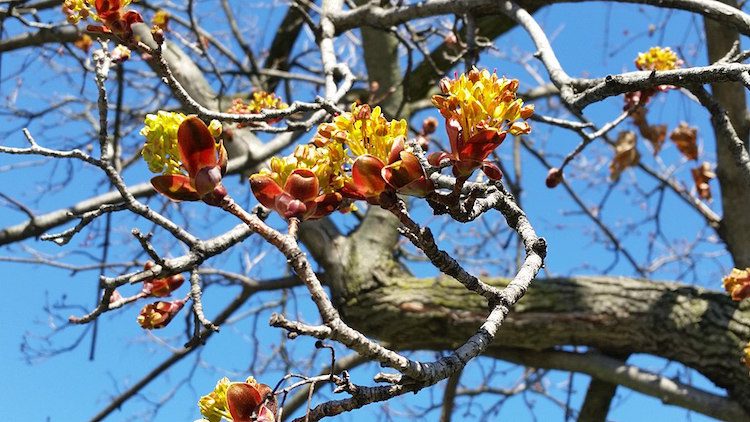
The earth around me is only now greening. It feels like Persephone is running a little late this year, although I’m sure that this is just my mortal impatience with all of the browness that yet lingers well into this rainy month. Catkins rustle dully as the chilly slaps of wind buffet them, desiccated stalks of bee balm and coneflowers, flattened by the repeated bludgeoning of snow and ice, cover the ground like discarded straw. It ain’t pretty here, folks.
Or perhaps it is. Perhaps in all the browns and blacks of death there is a different kind of beauty, a lesson to be learned as I wait for the hyper-vibrant hues of full Spring to overtake and saturate my senses.
It’s my practice to lean into those things that cause me discomfort, to explore the source of that discomfort and see what insights about myself I can glean. My impatience and weariness of greedy Winter, so reluctant to relinquish ascendency, becomes an opportunity for mindfulness, for observation, for slowing my own rhythms to be more in cadence with the rhythms of my Mother. What if, instead of obsessing over the eventual arrival of Spring, I instead opened my eyes to the dregs of Winter surrounding me right now, in this moment?
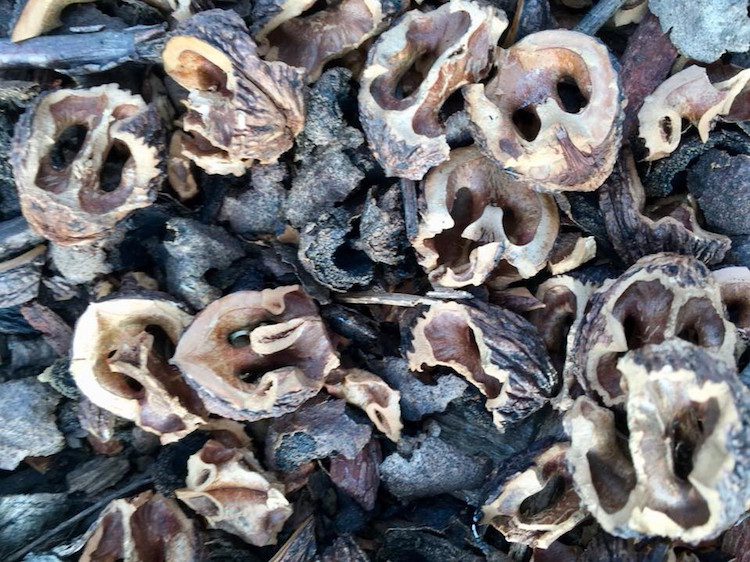
Owls, and Wisdom, Hidden in Plain Sight
At the center of the Heart Labyrinth, located on the grounds of the church I attend, is a black walnut tree. I discover dozens of walnut shells scattered around its base, husks cleaved open and scraped by ravenous squirrels eager for a juicy snack. On their slow path to devolving into humus, the walnut halves clutter and obscure the grey mulch under them. They look to me like a parliament of barn owls.
Mythological harbinger of death, symbol of the crone, solitary night hunter, what can you teach me? To wait and observe. To remember to use all of my senses and perhaps not be so reliant on sight as my primary means of understanding the world around me. To understand that all parts of the Great Cycle are critically important to the whole, interconnected and interdependent.
Well into my own crone years, this is a message I need to be reminded of. The texture of my skin is changing as I age, becoming drier, less pliant, rougher. My jowls are becoming more pronounced. The flesh of my neck is loosening and lopsided, courtesy of a surgery on my carotid artery a year ago. My waist-length hair, once lustrously black, is as grey as the weathered mulch under the walnut shells.
And yet this life-force within me remains irresistibly vibrant. The wisdom that so routinely eluded me in my younger years now flows through my fingers, my voice, my very way of being as effortlessly water flows downstream. I give thanks to the owls for the insights they have offered.
Blessings upon you who still give of yourselves even as you are overlooked, even as you are broken. May I be open to the lessons you offer.

We Make a Life by What We Give
(Thanks to Winston Churchill for the quotation.) Behind the Heart Labyrinth, tucked up into the stalky slope of the eastern corner of the property, is a festoon of spent milkweed pods. They’re glorious, big and sassy and faintly Georgia O’Keeffe-ish in their unabashed voluptuousness. “Behold,” they seem to say, “and imagine the lives we have sustained.”
In North America the Monarch butterflies are recovering from the brink of extinction thanks to thousands of individuals who have been mindfully planting and caretaking milkweed. The Monarch butterfly population is still anemic in numbers, but it is growing because a tremendous number of humans from Canada to Mexico, pretty much none of whom really know each other, responded to their plight and formed a support network for this non-human species.
Sustainer of life, what can I learn from you? That sometimes I’m not the star of the show, I’m the support staff. That I can give whatever nourishment I choose—be it tangible or intangible—freely, without expectation. That I can be someone’s waystation, someone’s safe house, someone’s soft landing place, and when they’ve been fed and rested and renewed I can say goodbye with a hope-filled heart and wish them well on their journey without getting stuck in mourning the loss of their presence. That I can have healthy boundaries and still be in relationship.
I am reminded of a Parker Palmer quote from his book, The Courage to Teach: “I want to learn how to hold the paradoxical poles of my identity together, to embrace the profoundly opposite truths that my sense of self is deeply dependent on others dancing with me and that I still have a sense of self when no one wants to dance.” I give thanks for the insights the milkweed has offered.
Blessings upon you who freely offer the gifts of unconditional nurturance and deep peace without expectation. May I be open to the lessons you offer.
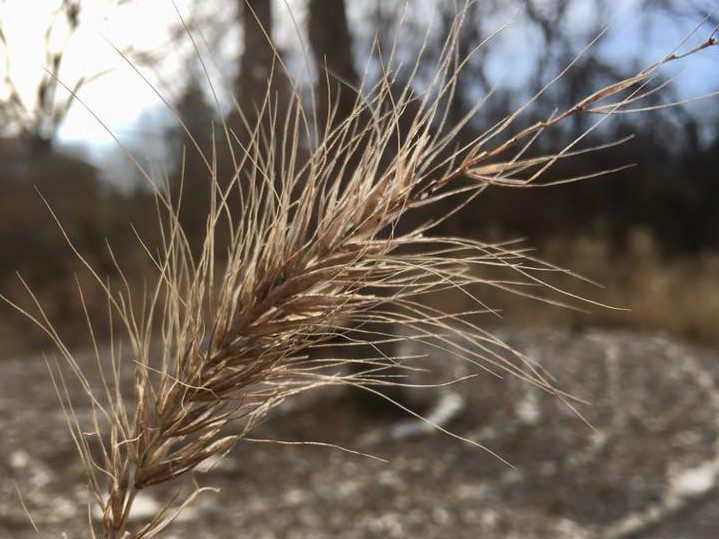
In an Ending, A Beginning
In high Summer, the path to the Heart Labyrinth is hidden from sight. In the native plant landscaping, Brown-eyed Susans, purple coneflowers, bee balm, and other prairie plants and grasses crowd the edges of the pathway. The vegetation is about three feet high and the path becomes a low channel through a wide river of indigenous flora. Though the black walnut tree at the center of the Labyrinth is easily visible it’s not an uncommon experience that, due to the combination of tall grasses and sharp bends in the path, visitors can’t actually see the Labyrinth until they’re practically upon it.
Now, though, so close to Beltane, the prairie’s stiff brown bushes are bare and the hollowed-out grasses have collapsed against each other like so much chaff. The limestones marking the lanes of the Labyrinth look like a ritual scarification, a permanent modification of tattooing upon the land. The stones are grey, the winter-worn mulch is grey; the Heart Labyrinth seems dormant and listless.
Well-traveled path, what do you have to teach me? What can I learn from you? Mindfulness, always mindfulness. To watch my steps and heed my surroundings. To be willing—and able—to pause on the journey and be fully present in the now even as the path seeks to pull me forward into the not yet. Acceptance, when I stumble over some loose mulch or unevenness in the path, for no journey of Becoming is smooth or without twists and turns. The patience not to hurry my steps in order to “get to the goal”; the center of the Labyrinth is not a goal but a turning point, simply another iteration of winding.
“Round and round the earth is turning,” goes the old English folksong, “turning always into morning, and from morning into night.” So too, of course, the seasons. So too, we in the Universe and the little universes in each of us. All spiral-dancing within ever-widening circles both seen and unseen, experienced firsthand or only faintly dreamed of at the edges of our knowing. I give thanks for the insights the Labyrinth has offered.
Blessings upon you who offer lessons of patience and mindfulness, who recall me into an exploration of my own heart’s labyrinth. May I be open to the lessons you offer.
May you journey your seasons with intention and integrity, with a joyful openness of heart and spirit, and in the deep knowledge that you are beloved of the Universe and all that is holy. In the words of Rabindranath Tagore, may “your life lightly dance on the edges of Time like dew on the tip of a leaf.”
Namaste, my friends.



